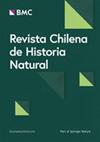Where is dinner? The spatiality of the trophic niche of terrestrial mammalian carnivores in Chile, a systematization for their conservation
IF 1.4
4区 环境科学与生态学
Q3 BIODIVERSITY CONSERVATION
引用次数: 0
Abstract
Knowing what the highest-level mammalian carnivores and intermediate levels eat throughout the geography and how human activities may affect their community dynamics is relevant information to focusing and deciding on conservation efforts within a territory. In this review, we characterize geographically the accumulated knowledge about the trophic niche of terrestrial mammalian carnivore species and evaluate the spatial relationship between the species richness distribution and the geographical distribution of their trophic knowledge in Chile. We found 88 peer-reviewed papers that include trophic studies per se, theses, and short notes carried out in Chile, where at least one trophic element was reported for terrestrial mammalian carnivore species. We found a positive relationship between the species richness distribution pattern and the spatial distribution of accumulated trophic knowledge, i.e., most of the papers have been conducted in Central-southern Chile (Central Chile and Temperate Forest ecoregions) responding to the highest co-occurrence of carnivore species within the limits of the biodiversity hotspot, the most threatened area in the country. Despite this general relationship, we recognize gaps in knowledge regarding regions of the country that require more research effort, such as O’Higgins, Maule, and Ñuble regions, as well as focus efforts on certain species with no or almost no knowledge of their trophic ecology, such as Leopardus colocola, Lyncodon patagonicus and Conepatus chinga. Except for the northern Chilean ecosystems, there is a generalized report of high consumption of exotic mammals in the diet of carnivores in the center and south of the country. However, of the 98 localities recognized in the 88 papers, 20.4% correspond to an anthropized environment, while most (79.6%) correspond to a “non-anthropized” environment or protected area. We hope this review allows researchers and decision-makers to consider the knowledge and lack thereof of carnivore trophic interactions as an opportunity to conserve entire natural communities throughout the Chilean territory.晚餐在哪里?智利陆生哺乳食肉动物营养生态位的空间性--一种保护它们的系统化方法
了解最高级别的哺乳类食肉动物和中间级别的食肉动物在整个地理区域内吃什么,以及人类活动会如何影响它们的群落动态,这些都是在一个区域内关注和决定保护工作的相关信息。在这篇综述中,我们从地理角度描述了陆生哺乳类食肉动物物种营养生态位知识积累的特点,并评估了智利物种丰富度分布与其营养知识地理分布之间的空间关系。我们发现了88篇经同行评审的论文,其中包括在智利进行的营养研究本身、论文和简短笔记,这些论文至少报道了一种陆生哺乳类食肉动物物种的营养要素。我们发现,物种丰富度分布模式与所积累的营养知识的空间分布之间存在正相关关系,即大多数论文都是在智利中南部(智利中部和温带森林生态区)发表的,这与该国受威胁最严重的生物多样性热点地区范围内食肉动物物种共同出现率最高的情况相呼应。尽管存在这种普遍的关系,但我们认识到,对于智利需要进行更多研究的地区(如奥希金斯、毛勒和尼布勒地区),我们的知识还存在差距;对于某些对其营养生态学一无所知或几乎一无所知的物种,如Leopardus colocola、Lyncodon patagonicus和Conepatus chinga,我们也要集中力量进行研究。除智利北部的生态系统外,智利中部和南部的食肉动物普遍食用外来哺乳动物。然而,在88篇论文中提到的98个地点中,20.4%属于人类活动环境,而大多数(79.6%)属于 "非人类活动 "环境或保护区。我们希望这篇综述能让研究人员和决策者考虑到对食肉动物营养相互作用的了解和缺乏,并以此为契机保护智利境内的整个自然群落。
本文章由计算机程序翻译,如有差异,请以英文原文为准。
求助全文
约1分钟内获得全文
求助全文
来源期刊

Revista Chilena de Historia Natural
环境科学-生态学
CiteScore
2.50
自引率
18.20%
发文量
9
审稿时长
>36 weeks
期刊介绍:
Revista Chilena de Historia Natural (RCHN) publishes original research dealing with past and present phenomena from organismic to higher levels of biological organization, considering both empirical and theoretical studies on all kinds of taxa and environments.
The major areas covered by RCHN are: botany and zoology; physiological and behavioral ecology; population biology; community and ecosystem ecology; systematics, biogeography and evolution.
 求助内容:
求助内容: 应助结果提醒方式:
应助结果提醒方式:


